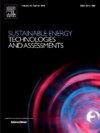Maximizing efficiency with active diameter modulation of vertical axis wind turbine
IF 7
2区 工程技术
Q1 ENERGY & FUELS
Sustainable Energy Technologies and Assessments
Pub Date : 2025-06-05
DOI:10.1016/j.seta.2025.104363
引用次数: 0
Abstract
Wind turbines rely heavily on prevailing wind conditions, yet the dynamic nature of wind often limits the efficiency of turbines with fixed dimensions. While previous research has explored variable concepts such as pitch angle, deformable aerofoils, etc., studies on variable solidity are scarce. This study proposes a novel variable diameter vertical axis wind turbine (VD-VAWT) designed to dynamically adapt to varying tip speed ratios (TSR), enhancing performance and expanding its wind capture range. This VD-VAWT comprises a special mechanism design that enables the turbine blade to slide along the strut. Experiments were conducted on a VD-VAWT with two straight-bladed NACA0018 aerofoils. Initially, the fixed diameter experiments spanning 300 mm to 800 mm were conducted which identified 600 mm as the optimal diameter, achieving a maximum power coefficient (CP, max) of 0.2748. The active control VD-VAWT demonstrated significant performance improvements, with power yields surpassing fixed diameter turbines by 34 % at 600 mm and 68 % at 800 mm. While changing its diameter, it can maximize the CP at different TSRs. In addition, the VD-VAWT enhanced self-starting capabilities, dynamic self-regulation for optimal conditions, and potential storm protection. This innovation demonstrates the potential of adaptable turbines to achieve higher efficiency and versatility in fluctuating wind conditions.

垂直轴风力发电机的主动直径调节,使效率最大化
风力涡轮机在很大程度上依赖于盛行风条件,然而风的动态特性往往限制了固定尺寸涡轮机的效率。虽然以往的研究已经探索了可变概念,如俯仰角、可变形翼型等,但对可变固体度的研究很少。本研究提出了一种新型变直径垂直轴风力机(VD-VAWT),旨在动态适应变叶尖速比(TSR),提高其性能并扩大其捕风范围。这种VD-VAWT包括一个特殊的机构设计,使涡轮叶片沿着支柱滑动。在两种直叶NACA0018型翼型的VD-VAWT上进行了实验。首先进行了300 ~ 800 mm的固定直径实验,确定了600 mm为最佳直径,获得了最大功率系数(CP, max)为0.2748。主动控制的VD-VAWT表现出显著的性能改进,在600毫米和800毫米时,其发电量分别超过固定直径涡轮机34%和68%。通过改变其直径,可以使不同tsr下的CP最大化。此外,VD-VAWT还增强了自启动能力、最佳条件下的动态自我调节能力和潜在的风暴防护能力。这一创新展示了适应性涡轮机在波动风条件下实现更高效率和多功能性的潜力。
本文章由计算机程序翻译,如有差异,请以英文原文为准。
求助全文
约1分钟内获得全文
求助全文
来源期刊

Sustainable Energy Technologies and Assessments
Energy-Renewable Energy, Sustainability and the Environment
CiteScore
12.70
自引率
12.50%
发文量
1091
期刊介绍:
Encouraging a transition to a sustainable energy future is imperative for our world. Technologies that enable this shift in various sectors like transportation, heating, and power systems are of utmost importance. Sustainable Energy Technologies and Assessments welcomes papers focusing on a range of aspects and levels of technological advancements in energy generation and utilization. The aim is to reduce the negative environmental impact associated with energy production and consumption, spanning from laboratory experiments to real-world applications in the commercial sector.
 求助内容:
求助内容: 应助结果提醒方式:
应助结果提醒方式:


